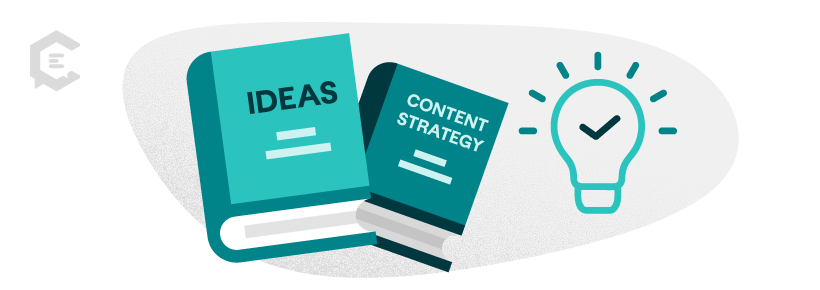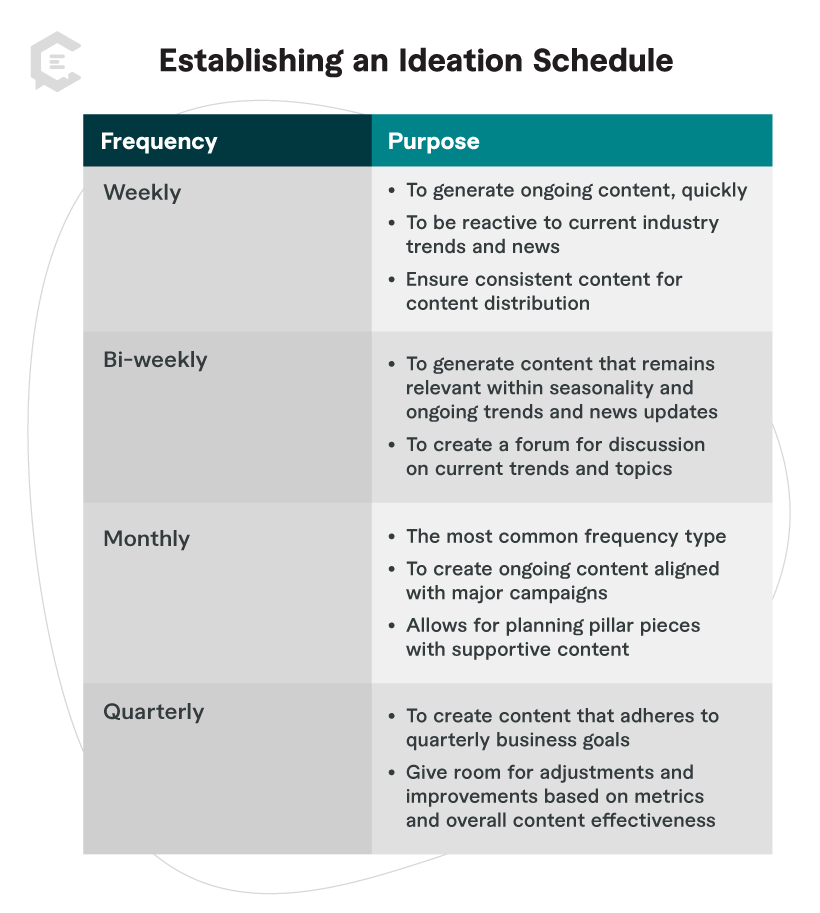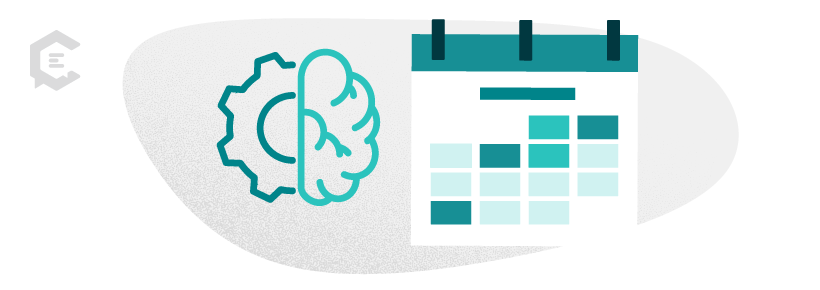You’re likely familiar with the term “ideation,” whether you’re a copywriter, graphic designer, social media lead, or strategist.
Whether you’re new to the game or have been at it for a while, you might ask yourself, “How much ideation is enough?” This is valid: Too little ideation can lead to lackluster content, content gaps, and a disenchanted audience. Too much might result in “decision paralysis” or burnout while stretching your resources too thin.
The goal of an ongoing and productive content strategy is ideation frequency, which, as Goldilocks and the Three Bears put it, is “just right.”

Ideation and Content Strategy
Before determining the “how often,” let’s examine the “what.” A successful ideation strategy has four components:
- Identifying and solidifying topics to engage audiences, provide solutions, and impart knowledge
- Determining themes and issues to support your brand’s strategies and goals
- Formulating audience-friendly formats through which useful, engaging, and interesting content is delivered
- Measuring the effectiveness of content, formats, and audience engagement and making changes to the process when necessary
The above is built on a foundation of your organization’s goals and your audience’s pain points. Once you’ve determined those objectives and needs, it’s time to determine how often to brainstorm.
Establishing an Ideation Schedule
In theory, you could meet with your team daily and kick around great ideas for those blogs, video tutorials, or podcast series. In reality, no one has that kind of time. The following chart provides a good idea of ideation meeting frequency.
There are various frequency timelines and a reasoning for each. For instance, you may follow one of the following or something in between:
- Weekly: This is used to generate many ideas and fast. It allows you to be reactive to sudden industry news or changes and ensures enough content for your social media and blog.
- Bi-weekly: This tends to be great for staying on top of any ongoing trends or seasonal changes, as well as discussing and continuing conversations on topics or formats currently ongoing.
- Monthly: This may be the most common frequency type. It is used to formulate ongoing and major campaigns within your marketing operations. It allows you to plan and schedule pillar content pieces. Think of the hub and spoke model. And provides for ongoing engagement with your audience.
- Quarterly: This is often used to examine quarterly metrics and content effectiveness. Many use this frequency to align with quarter business goals and adjust to those current and/or new goals.
Content schedule
An up-to-date content schedule determines how often your team meets. That schedule also dictates when more content (and, therefore, more meetings) could be necessary. For example, you might have a higher content push during certain times of the year.
Industry trends
Your content must reflect industry developments to ensure greater audience engagement and action. If your organization operates in a field experiencing many changes, you need to meet more often with your ideation team to develop content that addresses various issues.
Audience engagement
If your audience has an ongoing relationship with your content, it’s time to pop the champagne. To keep attention and interest, you should plan to meet regularly to ideate new topics, formats, and distribution efforts.
Available resources and capacity
Larger teams generally have the budget and capacity to meet more frequently (as well as having greater content needs). However, if your team consists of a copywriter, designer, and SEO specialist (with a smaller budget), you’ll likely get together less frequently to ideate.
At ClearVoice, we’ve often found that many customers have a desired monthly cadence of content that varies across different content formats. But that helps tee things up for ideation cadence and amount. We’ve determined it’s always best to double the desired amount. So, if there’s a need for eight blog posts a month, we need to ideate a minimum of 16 post ideas. Those ideas should include a working title, a brief description, and any specific reference link for support or comparison.
Choosing the Topics to Ideate
Once you’ve determined ideation frequency, it’s time to work on the content process. One issue involves timely versus evergreen topics, which are essential for a balanced content strategy. Selecting which to use will depend greatly on your content schedule, organizational goals, and, of course, audience engagement.
Timely content: Getting it done now
Timely content is used for current events, trends analyses, or seasonal campaigns. The goal here is to gain your audience’s immediate attention with content like:
- Social media posts and “newsy” website blogs
- Infographics, charts, and graphs
- “Trending” podcasts
- Topical webinars
Timely content drives short-term traffic. Once a trend disappears, a season ends or a fad fades into oblivion, so does the content’s relevance.
Evergreen content: Distributing whenever
Pine trees in forests — evergreens — stay green year-round. Your evergreen content does the same thing. It remains relevant over time, no matter when your audience engages with it.
- Evergreen content includes:
- Website resource pages
- Blog or website FAQs
- “How-to” video tutorials
- eBooks or white papers
Evergreen pieces attract and engage audiences over a longer period, with relevance continuing over time.
Finding the topics
A topic list is essential for results-driven ideation. Yet one issue plaguing many marketing teams is where to find likely ideas. Brainstorming with your team is one way to generate concepts. Other sources include:
- Audience/stakeholder feedback
- Secondary sources (news articles, research papers)
- Digital idea generators, including HubSpot’s Blog Ideas Generator and AI tools like Chat GPT or Gemini
Having topics ready at ideation meetings can reduce discussion time and possibly the frequency of how often you meet with your team. Additionally, another invaluable way to pinpoint ideation topics is through keyword research.
Ideation, SEO, and Keyword Research
Your content should be engaging. It should also rank high on a Search Engine Results Page. The higher your content ranks, the more eyeballs view it. The more people look at your content, the more likely they are to act favorably.
As such, a successful ideation strategy relies on search engine optimization (SEO) and keyword research through the following:
- Use the right tools. Google Keyword Planner, Semrush, and Moz are great for identifying keywords. If possible, also study long-tail keywords to help drive higher conversion rates.
- Incorporate content mapping. Content mapping matches keywords to content type. For example, question-focused keywords can be re-created as FAQs, while “how-to” keywords can be the basis of video tutorials.
- Focus on content relevance. It’s important to understand users’ needs when they type queries into search engines. Understanding user pain points helps in designing effective content.
- Perform a content gap analysis. Look for any information “gaps” your audience might face when searching for solutions. If you find a lack, develop content to fill it.
Organizing Ideas from Ideation Sessions
Figuring out how often to get your team together is essential. Getting team members to pitch in ideas is also necessary. Once those topics and ideas are in place, it’s time to organize them. The better the organization, the better — and more effective — the resulting content. The best methods of organization include:
Documenting all contributions. Use a central digital tool like Trello, Asana, Google Docs, or Miro. Or go old school and record everything on a whiteboard. It doesn’t matter as long as everything is captured. While you’re at it, take time to categorize ideas to save time.
Grouping ideas under specific categories. Once the ideation session is complete, take the time to organize those terrific thoughts, discussions, and topics under specific categories. These groupings can include (but aren’t limited to):
- Thematic (new product launches, seasonal trends, news events)
- Content types (blogs, infographics, white papers, podcasts) and audience preferences)
- Release dates (timely versus evergreen)
Ensuring topics align with audience needs and organizational goals. Ultimately, the topics should focus on specific objectives (lead generation, sales conversions, website visits) while increasing brand awareness.
Assigning ownership for each topic. The team or individual you delegate is responsible for taking the necessary steps to get an idea from concept to execution. Be sure to follow up; the last thing you need is for things to fall through the cracks.
Topic organization is one reason why ideation frequency consideration is essential. If you’re meeting too often with your team, you could end up with many ideas. But you might not have enough time — or resources — to move those ideas into actionable content.
Further Optimization of the Ideation Process
Ongoing scheduling, regular meetings (but not too many), in-depth research, and stimulating discussions are essential methods that support ideation strategies. Other best practices to incorporate include the following:
- Incorporate cross-functional teams. Bring others into your ideation process, like folks from the sales and production departments. Don’t keep it to just the marketing team.
- Stick to the agenda. Brainstorming is fun. It can also be long-winded. Create a concise agenda to keep your team on track while discussing topics, formats, and distribution processes.
- Follow the feedback. Study metrics to determine if the resulting content from ideation processes increases conversions, engagement, click-throughs, or views. Also, tap into audience feedback loops for responses to your content and to generate future ideas.
- Constantly review and refine. Ideation is not a “one-and-done” process. Continually examine your ideation process, from meeting frequency to content creation and distribution. If something isn’t working, figure out why and change it.
Ideation Frequency for Stellar Content
A key to a well-oiled ideation strategy is brainstorming ideas. Another key is how often you meet with your team. Ideation frequency greatly depends on your organization, industry, resources, and audience. Consistency is important whether you have a brief daily meet-up or a two-hour monthly gathering.
So be alert to the signs that you might be ideating too much (burnout, indecision, too many ideas for effective topic organization) or not enough (lackluster content, content gaps, dwindling audience engagement).
If you need help with your ideation process, we’ve got your back. Our professional content strategists, editors, and writers can provide superior assistance at any point during your content strategy process. Connect with a content strategist today to discuss your content creation and ideation needs.








